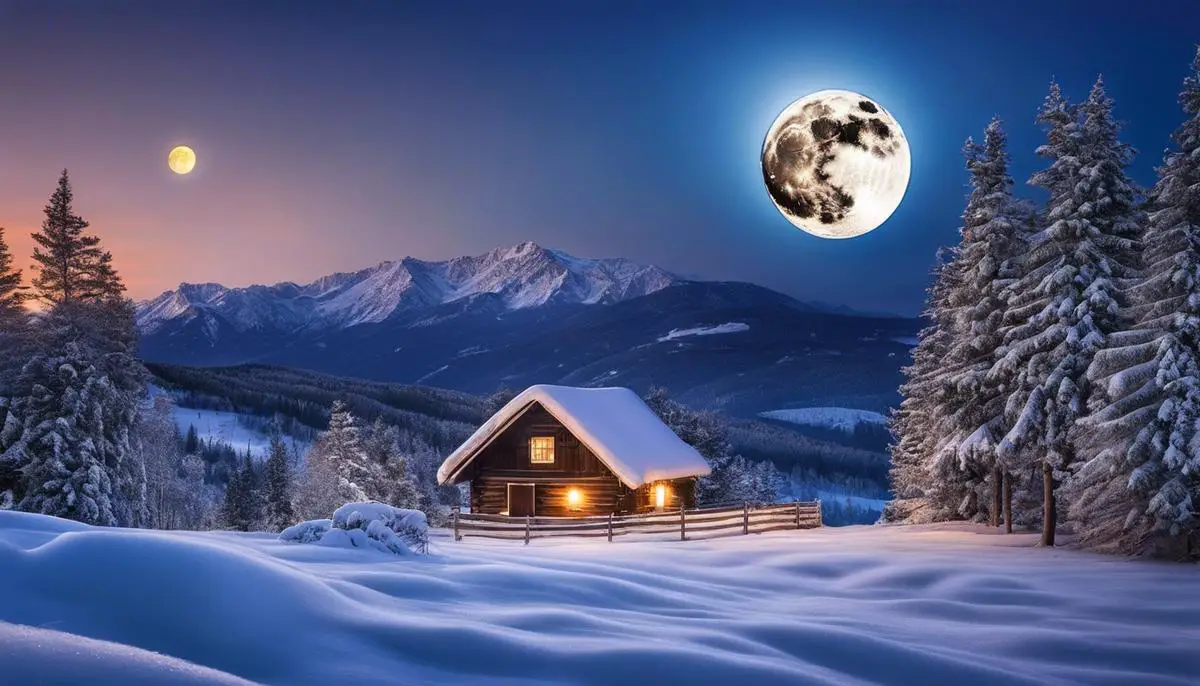Each December, the skies bestow upon us an occurrence of mesmerizing beauty and intriguing phenomenological depth – the Full Cold Moon. As the highest full moon within our calendar year, it hangs luminously, marking the advent of winter and bringing with it rich implications and impacts in numerous areas of human life and Earth’s ecology. Central to both scientific understanding and cultural folklore, this astronomical event is steeped in intrigue and wonder.
The Phenomenon of the Full Cold Moon
Full Cold Moon in December: An Interplay of Cosmic Phenomena and Earthly Seasons
The celestial lights that dot the night sky have long captivated the hearts and minds of scientists and scholars alike. Among these cosmic spectacles, the moon, with its numerous phases and recurring cycles, holds a particular fascination. One of the most notable lunar events is the Full Cold Moon in December. This subject shall be the guidepost for our ensuing discourse, offering insight into the beautiful synergy of Earth’s climatic patterns and the universe’s expansive ballet.
Traditionally, the Full Cold Moon is the last full moon of the calendar year, typically occurring in late December, near the winter solstice. This designation is steeped in the wisdom of generations past, specifically the Native American tribes who lived close to the land and moon, intertwined inextricably with both.
The descriptive term “Full Cold Moon” was coined by these tribes in reference to the frigid conditions characterizing this period of the year. As the daylight hours dwindles and the winter chill sets in, the appearance of the Full Cold Moon is a potent symbol for the commencement of the deep winter. The symbiosis between indigenous wisdom and the lunar cycle’s influence on the environment highlights an early recognition of astrophysical elements in seasonal changes.
Present-day scientists recognize the Full Cold Moon as an aspect of a broader astronomical cycle. The moon orbits the Earth roughly every 27.3 days, a period known as sidereal month. Throughout this cycle, the moon manifests various phases due to the relative positioning of the Earth, moon, and sun and the corresponding shadows cast. The full moon phase, encapsulating the Full Cold Moon, occurs when the moon and the sun are in direct opposition, which allows sunlight to fully illuminate the moon’s surface visible from Earth.
Few spectacles could be regarded as poignant as the Full Cold Moon hovering over a frozen landscape. The radiant lunar light reflecting off snowy terrains lends the moon a more luminous and larger appearance, often entrancing onlookers. This is primarily due to a phenomenon known as the moon illusion, wherein our brain, influenced by the surroundings and the horizon, perceives an object, in this case, the moon, as larger than it is.
The Full Cold Moon serves not merely as an indicator of the transition into deep winter but also has profound implications within the astronomical community. Detailed observational studies during the full moon phase aid in advancing lunar research and understanding its geologic dynamics.
The embrace of the Full Cold Moon phenomenon extends beyond the realms of astronomers and academics, touching on cultural and spiritual spheres. It is a testament to the enduring enchantment of the celestial world and how deeply it is embedded in humanity’s collective consciousness.
This exploration of the nature of the Full Cold Moon and its significance elucidates the remarkable and meaningful connections between our Earthly existence and the celestial patterns overhead. The phenomenon’s cyclic regularity and predictable occurrence offer reassuring continuity in our rapidly evolving world, reminding us of the eternal wisdom embedded in our universe’s panoramic dance.
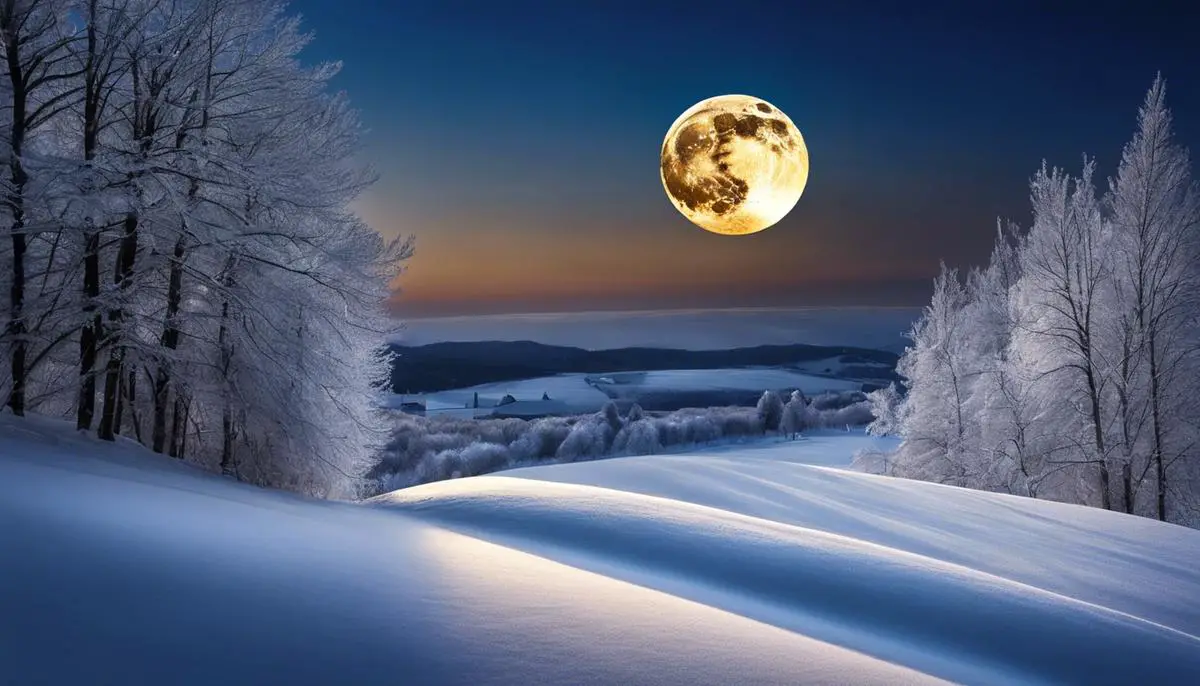
Astronomical Science behind the Full Cold Moon
Elucidating the scientific basis entails understanding the intricate weave of natural phenomena that results in the occurrence of the Full Cold Moon. There’s a sublime beauty to the clockwork efficiency of the cosmos, and the occurrence of this particular moon phase is a testament to that.
At its core, the Full Cold Moon, appearing in December, is an astronomical event involving an intriguing synergy between the Earth’s axial tilt and the moon’s orbital position. This timing results in its coincidental appearance during the peak winter period, thus earning the moniker.
As Earth undertakes its annual journey around the Sun, the tilt of the axis results in seasonal disparity rooted in the variation of solar influx received by different regions. The axis points away from the Sun during winter solstice in the Northern Hemisphere, of which the Full Cold Moon is a signpost. Thus, the advent of the Full Cold Moon inevitably portends colder temperatures in this part of the world.
The Full Cold Moon, carrying the favor of being the longest full moon of the year, is an outcome of the moon’s orbit’s elliptical nature. As the Moon nears its apogee – the point in its orbit whereby it is farthest from Earth – our common satellite appears to linger longer in the sky. This lingering visibility is due to the Moon’s slower orbital speed at apogee, in line with Kepler’s laws of planetary motion. Coupled with early sunset hours courtesy of the winter solstice, an observer would find the Full Cold Moon virtually hanging in the sky, inculcating the essence of a quiet winter night.
Interestingly, besides the sheer astrophysical mechanics, the Full Cold Moon illuminates our cognition. The brightness of full moons has been linked to several behavioral studies, revealing intriguing human and animal responses. Notably, the Full Cold Moon could contribute to sleep disturbances, a sparkle in the cognitive research ambit.
While these important avenues of study burgeon, we can delve deeper into our understanding of the Full Cold Moon linking it with the overarching framework of ecology. The unique positioning of the Full Cold Moon not only affects human behavior but can influence the breeding patterns and migratory behaviors of several animal species, an arena worthy of active exploration.
Scientifically, the Full Cold Moon comprises multitudes – from tracing the axioms of our solar system’s mechanics, through the windows of human cognition and animal behavior, and right down to the subtler shifts of our ecosystems. This celestial phenomenon, while casting a cold silvery light onto the Earth, stands as a tangible connection between our planet, the cosmos and everything that calls Earth home. Understanding the Full Cold Moon is, in essence, a testament to the interconnectedness we share with the universe.
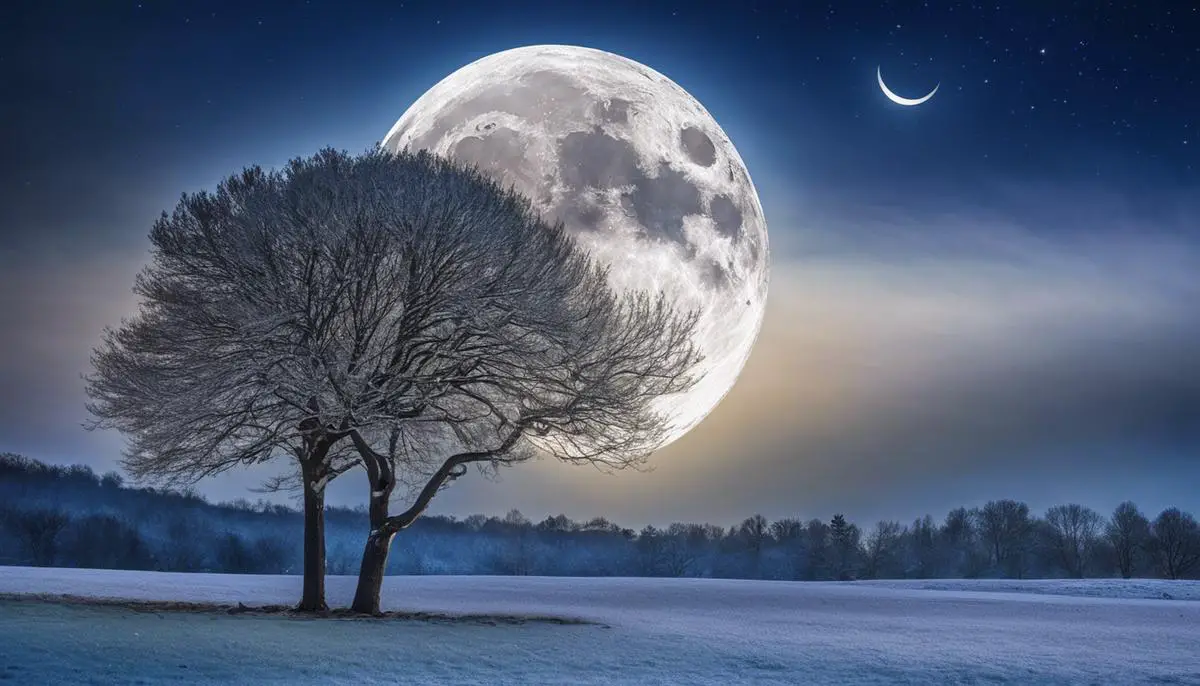
Full Cold Moon’s Impact on Earth’s Ecosystem
Behold, the enigmatic intricacies of Earth’s ecosystems and their celestial cognoscenti – particularly the Full Cold Moon – present a veritable tapestry of interwoven relationships and interactions, revealing a complex and fine-tuned balance. Emerging from this delicately balanced interaction are ecological symphonies that conform to and align with this celestial phenomenon.
In analyzing the Full Cold Moon’s effect on Earth’s ecosystems, it’s paramount to delve into the manifestation of nighttime illumination. With the Earth positioned so that the moon is fully illuminated by the sun, this ethereal beacon of the night achieves its maximum brightness, transforming the nocturnal landscape into an arena of enhanced visibility. This additional light during the night can heavily influence organisms that are adapted to operate during the twilight – the difference between night and day in terms of predator or prey becomes a matter of life and death.
The Full Cold Moon’s increased luminance disrupts the equilibrium of nocturnal predation. Species relying on nighttime cover often find their survival mechanisms compromised. Conversely, for the predators depending upon night hunting, the enhanced visibility presents a veritable feast. This disturbance in predatory and prey dynamics during these specific periods affects population numbers and predator-prey equilibrium, leading to potentially significant ecological cascading effects.
Turning our attention towards marine ecosystems, the noteworthy influence of the Full Cold Moon is profound as well. Marine tidal cycles, triggered by the moon’s gravitational pull, are heightened during this phase. These heightened tides can disrupt intertidal zones’ delicate ecosystems, influencing the physical distribution and activity of species within this environment. These impacts translate not only into changes in population dynamics but also in the overall energy flow and species interactions within these ecosystems.
Avian creatures also owe much of their migratory and breeding behaviors to the moon’s various phases, particularly the Full Cold Moon. Changes in light intensity, combined with climate cues, often trigger certain behaviors that are critical for survival. Migratory birds may use the increased light for navigation during long-distance migrations, while others may time their breeding cycles according to such lunar events to maximize resources for offspring.
Then there is the influence of the Full Cold Moon on plant biology. The moon phase’s effects on plant growth and development, though subtly intricate, cannot be ignored. Some research suggests variations in moonlight intensity might influence plant photoperiodism – the physiological response of organisms to the length of day or night. This, collectively with other climatic factors, influences plant reproductive phases and growth patterns, thus affecting the broader ecosystems they inhabit.
In sum, the Full Cold Moon navigates the intricate web of life, silently guiding the symphony of Earth’s ecosystems. This celestial phenomenon, with its mesmerizing beauty, orchestrates a ballet of life and survival. It’s a testament to our planet’s interconnectedness with the cosmos, buzzing with life, evolving, adapting, and conforming to the silent whistle of the Full Cold Moon. Understanding these celestial fingerprints on Earth’s ecological narratives fosters not only appreciation but also contributes to the global conservation dialogue. A dialogue that recognizes the universal language of science, intertwining us with the cosmos in an eternal serenade of existence.
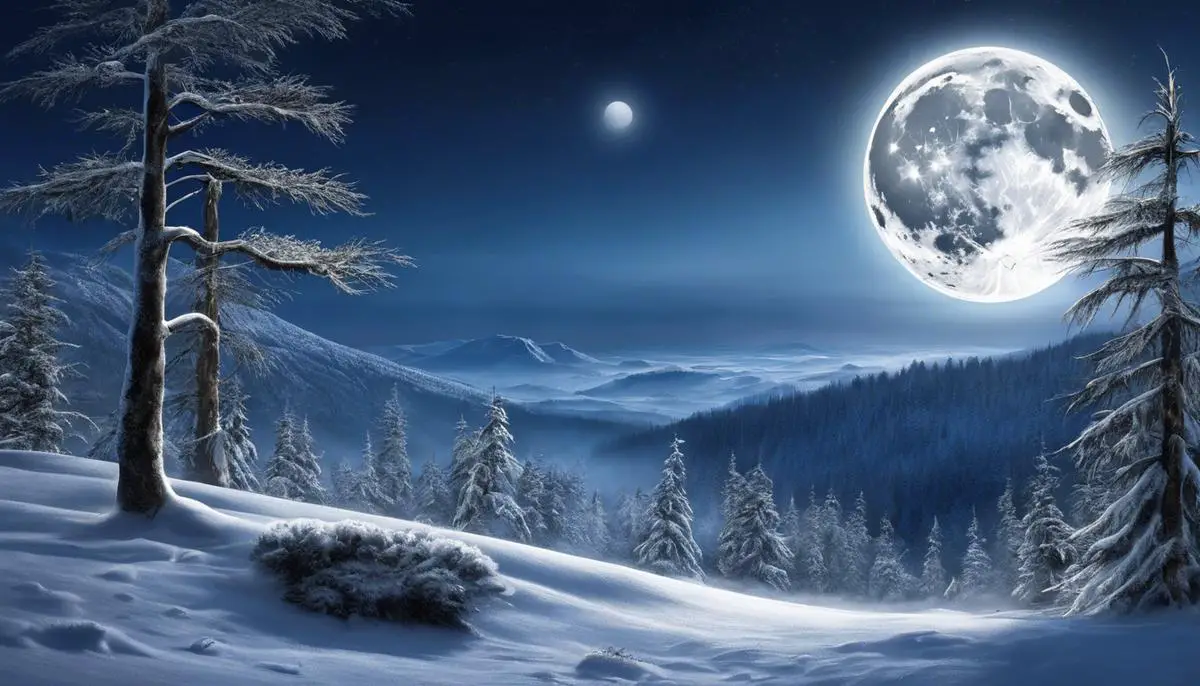
Observational Techniques for the Full Cold Moon
The observational techniques for the Full Cold Moon are intrinsically linked to the nature and properties of this celestial spectacle. Acknowledging the importance of the moon’s brightness during this phase is crucial in understanding its observational significance. During the Full Cold Moon phase, lunar illumination reaches a peak, providing an optimal opportunity to study its surface characteristics more vividly than during other lunar phases.
One notable observational approach involves the use of a telescope. Suitable lenses are necessary for in-depth lunar investigations. High contrast filters and apochromatic lenses are beneficial to reduce the bright glare produced by the moon’s surface. The former improves surface detail visibility while the latter corrects the color aberrations caused by the telescope’s optics.
Lunar photography is another technique widely adopted during moon observations. The full roundness of the Full Cold Moon provides a perfect subject for the camera. Employing a versatile camera with adjustable settings for shutter speed, ISO, and aperture is highly recommended.
Deriving clear pictures requires an aperture setting that manifests a sharp focus over a broader field, and a higher shutter speed can effectively minimize the moon’s apparent motion. Employing a lower ISO setting avoids excessive image noise, despite capturing the moon’s intense brightness. The use of the “Looney 11” rule, a guiding principle for lunar photography, proves incredibly helpful for balancing these settings.
Furthermore, viewing the Full Cold Moon through binoculars fosters a more intimate lunar relationship, rightfully suiting those thirsting for the immediacy of the experience. Binoculars with a larger aperture provide brighter lunar images with more detail. Importantly, astronomical binoculars should possess a magnification strength less than 20x for a wider field of view and relative stability against hand movement.
When concerning observations in the visibly polluted cities, lunar filters augment the viewing experience. They tend to reduce glare and increase contrast, permitting naked-eye viewers to perceive more detail.
Irrespective of these sophisticated techniques, an often underplayed yet essential factor is the weather. Observationally, a clearer, less clouded sky is always preferred. Weather applications or astronomy-oriented websites can provide accurate regional weather forecasts, aiding in planning observational studies of the Full Cold Moon.
The Full Cold Moon is not merely a phase of our celestial companion; it is a complex ecological component, heavily influencing Earth’s ecosystems. The illumination it provides changes the predatory-prey dynamics, influences marine tidal cycles, and subtly impacts plant growth. Acknowledging the moon’s influences on wildlife encourages global conservation efforts and provides a deeper appreciation for the interconnectedness of all natural phenomena.
By employing these observational techniques and recognizing the profound earthly impacts, the Full Cold Moon becomes much more than a spectacular celestial event. It emerges, truly, as a compelling study of Earth’s ecological complexities and an inspiring symbol of the wonders emanated by our universe’s interconnectedness.
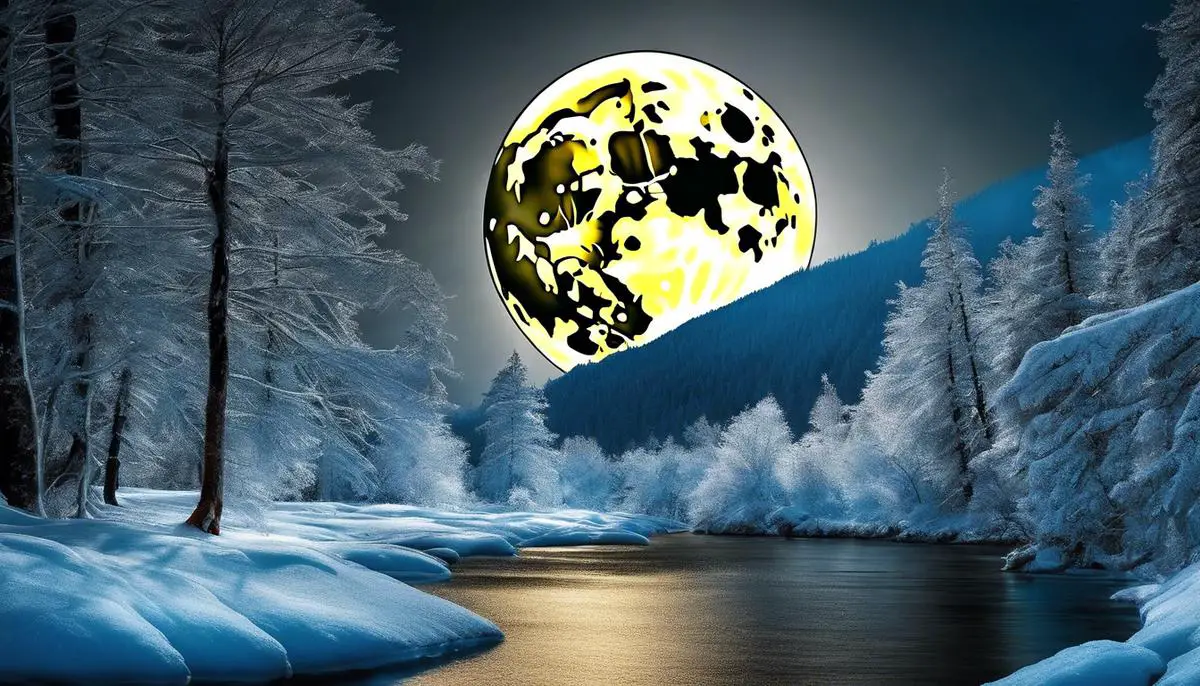
The Full Cold Moon in Popular Culture and History
The Full Cold Moon
The Full Cold Moon holds an invigorating yet quiet prominence in popular culture and historical events. This luminous phenomenon, visible at its peak in the prolonged nights of December, has unfurled its influence subtly, marking an indelible impression through different ages and cultures.
One exceptional example of the Full Cold Moon’s impact on popular culture can be observed in literature. Poets and authors alike, from diverse cultures and eras, have used this celestial muse as a poignant metaphor to symbolize the advent of endings, the concept of isolation in the frosty month, or even the anticipation of a fresh beginning. It is unsurprising that literary figures, moved by the serenity of the Full Cold Moon hanging in the December sky, have imbued their works with its essence, thus propagating its allure in the realms of popular culture.
The Full Cold Moon has not only cast its glow in literature but has also robustly permeated religion and mythology. For instance, in certain ancient Greek mythologies, it was associated with Selene and Artemis, deities that represented the moon. Here, the Full Cold Moon serves as a symbol, further enhancing the narrative with its ethereal charm.
Moving from the sphere of culture to history, patterns emerge that suggest the Full Cold Moon’s influence on historical events. It is speculated that the Full Cold Moon has often served as a beacon during nighttime warfare. Its luminosity provided visibility, serving as a natural, omnipresent guide during times when such tactical advantages were slim. The strategic implications of these lunar occurrences undeniably influenced the outcomes of numerous historical events.
In addition, Full Cold Moon festivals have punctuated the histories of cultures worldwide. In China, the Dongzhi Festival, which roughly coincides with the Full Cold Moon, symbolizes the return of longer daylight hours and an increase in positive energy. Thus, the Full Cold Moon is inextricably woven into the fabric of society, from cultural beliefs to momentous occasions.
Furthermore, our fascination with the Full Cold Moon isn’t limited to land-based observations. Numerous lunar missions by organizations such as NASA have been meticulously scheduled around the lunar phases with special considerations often provided to the Full Moon phase. On December 14, 1972, during the Full Cold Moon, Apollo 17 left the lunar surface and began its successful journey back to Earth. This was humanity’s final moonwalk of the Apollo missions, rendering the Full Cold Moon symbolic of endings yet again.
In conclusion, while the Full Cold Moon is often seen as a mere celestial occurrence, its influence spans across literature, culture, mythology, historical events, and space explorations. Provoking a sense of quiet reflection, it serves as a linkage forging deep connections between the cosmos and the terrestrial world. The Full Cold Moon’s spectral illumination decorates our skies, our cultures, and indeed our lives. And knowingly or unknowingly, we remain truly interconnected with this striking lunar event. The Full Cold Moon is not just a part of our sky but also a part of who we are, shaping the broad spectrum of human existence in distinctive and nuanced ways.
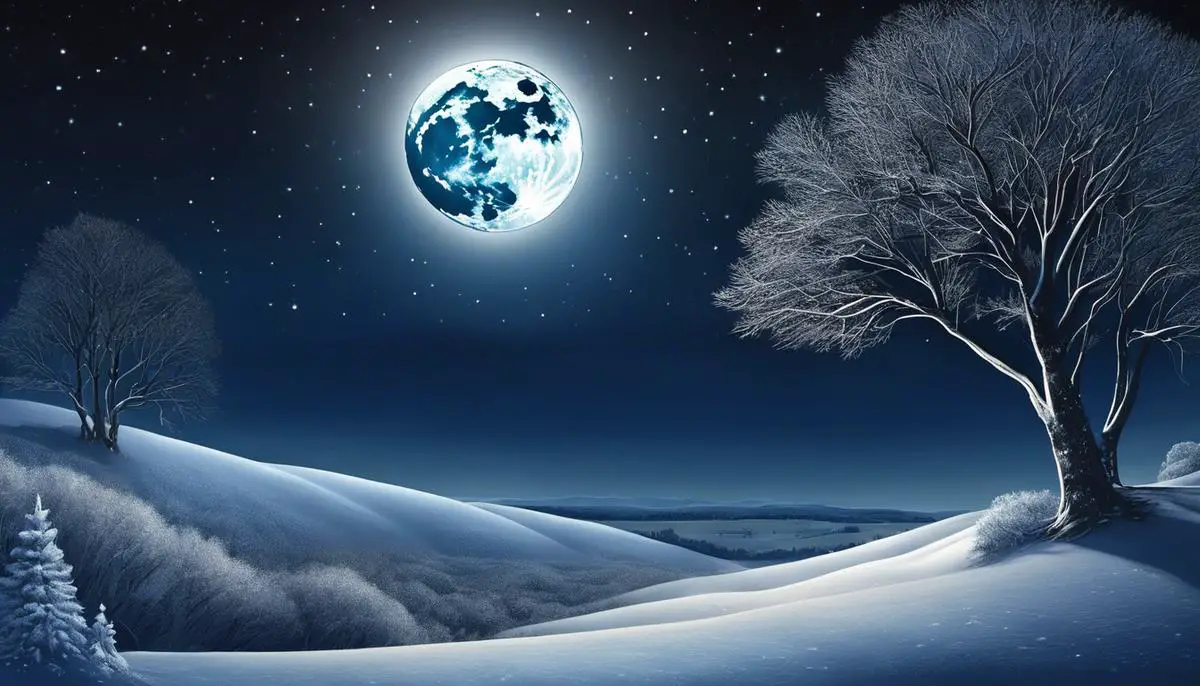
As our exploration of the Full Cold Moon unfolds, we find its remarkable effects permeating our natural world, scientific sphere, and cultural realm, echoing its radiance throughout human history, mythology, and popular culture. Irrespective of our individual beliefs or understanding, each one of us has, at one time or another, been a silent observer to its magnificent display. Henceforth, equipped with enhanced knowledge and insight about the Full Cold Moon of December 2023, we might gaze up with newfound admiration, feel a deeper connection to Earth’s ecosystems, and appreciate its significant role in the great dance of celestial bodies.
![]()
